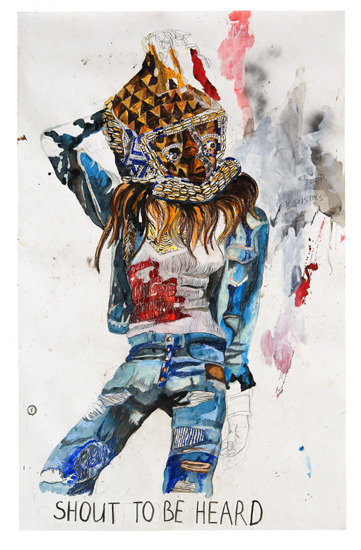Charlotte Schleiffert
dal 6/3/2013 al 19/4/2013
Segnalato da
6/3/2013
Charlotte Schleiffert
Barbara Gross Gallery, Munich
Spring. The new drawings present hybrid creatures, in which social, religious, and sexual discourses cross. Schleiffert combines her experiences in various cultural landscapes with experiences of popular youth cultures.

Charlotte Schleiffert dares to explore difficult themes, which she translates in unconventional ways, with humor and elegance, into expressive drawings. She deals with intolerance, power, violence, poverty, and social injustice, as well as with the fixation on gender roles and conflicts among different cultures and ethnicities.
Schleiffert’s travels and sojourns abroad are an important source of inspiration for her. Wherever she is in residence, she introduces into her works of art the ways that local media - from glossy fashion magazines to serious news channels - are received. During a residency in Paris last year she was fascinated by the masks and traditional robes from various cultures that were on display in the Musée du quai Branly, the anthropological museum for non-European art.
Paris fashions also influenced her most recent works of art. In her series of portraits of Africans and Europeans, shown here for the first time, the Europeans, in their splendid clothing modeled after the French Baroque style, appear insignificant next to the Africans in their colorful tribal paints. The Orient meets the Occident - not, however, from the colonial point of view, but in the form of an ethnographic appreciation that demonstrates the beauty, the pride, and the strength of the peoples of diverse foreign cultures.
Her large, new drawings present hybrid creatures, in which social, religious, and sexual discourses cross. Schleiffert combines her experiences in various cultural landscapes with experiences of popular youth cultures, such as the rocker or hip-hop scenes. Traditional, archaic, ritual masks meet motorcycles and jeans. The larger-than-life-size figures pose as mythical creatures or modern warriors in front of a white background. Unframed and painted in strong colors with rough brushstrokes, they call to mind flyers or posters.
A series of drawings titled Töten war so leicht wie Wasser trinken (Killing was as easy as drinking water) is inspired by the photos and photojournalism that Schleiffert found in German newspapers while she was in residence at the Künstlerhaus Bethanien in 2008. She works with a variety of headlines, from the closing of the Nokia factory in Bochum and the demand for a regulated, mandatory minimum wage, to an article on the founding of a women’s soccer team in Afghanistan and the humanitarian disaster in the troubled country of Chad. By capturing these reports in her drawings, she prevents these themes from being forgotten amid a flood of digital images.
Charlotte Schleiffert, born in 1967 in Tilburg, the Netherlands, lives and works in Rotterdam, the Netherlands, and Xiamen, China.
Solo exhibitions (selected): Museum Het Domein, Sittard, Netherlands, 2011; Kunstverein Glückstadt, 2006; Museum Boijmans van Beuningen, Rotterdam, 2004; Chinese European Art Centre, Xiamen, 2003. Group exhibitions: Rebelle Museum voor Moderne Kunst, Arnhem, 2009; Cultural Center Montehermoso, 2008; Stedelijk Museum, Amsterdam. Residencies: Atelier Holsboer (Cite des Arts), Paris, 2012; Künstlerhaus Bethanien, Berlin, 2007/2008; CEAX, Xiamen, China, 2003.
Opening: Thursday, March 7, 2013, 7–9 pm
Barbara Gross Gallery
Theresienstr. 56 Hof 1, Munich
Hours: Tue–Fri 11 am–6.30 pm, Sat 11 am–4 pm
Free Admission



